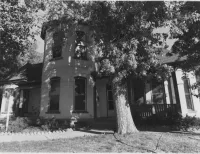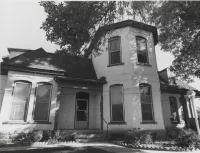Share what you know,
and discover more.
Share what you know,
and discover more.
Mar 30, 1978

-

- Charmaine Bantugan
National Register of Historic Places - John M. Whitaker House
Statement of Significance: The John M. Whitaker House is significant for its association with its original owner, occupant and namesake, John Mills Whitaker, a man important for his contributions to his church, business, educational and political community. His voluminous journal and papers are a valuable local history resource. HISTORY John M. Whitaker was an active and prominent member of the Church of Jesus Christ of Latter-day Saints during its early years in the Salt Lake Valley. During his lifetime he saw the church emerge from the trying pre-manifesto days to its present condition. As a young man Whitaker knew intimately men whose lives reached back far beyond Civil War days. He was acquainted with Mormon Church President John Taylor and married his daughter Ida in 1886. He worked with John Young, son of Brigham Young, on some of the great railroad projects of Utah. Whitaker witnessed the dedication of the Salt Lake Temple and saw Utah enter into statehood. As one of the early residents of the Sugarhouse area, Whitaker developed what came to be known as the Verona Water System, the earliest supply of water in that location. The papers of John M. Whitaker contain the many facets of his long life: missionary, bishop, patriarch, teacher and speaker in the L.D.S. Church as well as horticulturist," builder, educator, politician, businessman and diarist. His business life included employment as the secretary of John W. Young and the building of the Salt Lake and Eastern Railway, manager of the Taylor Brothers Real Estate Company, assistant secretary and ticket and passenger agent of the Utah Light and Railway Company. He later became head of the office of the Utah Light and Railway Company (Utah Power and Light), manager of the Deseret Employment Bureau, and Civic Employment Bureau and paymaster for the Civic Works Administration. Whitaker was best known for his role in church activities and administration. He faithfully recorded what he saw and heard, and carefully preserved written information of all kinds. For fifty years he recorded for the press all the General Conferences of the Church of Jesus Christ of Latter-day Saints. He also initiated the tremendous growth of the seminary movement in the Mormon Church. His seminary teaching, the establishment of a Free Public Library which later became the Salt Lake Stake Library and his activities during the depression with unemployment in church and state marked the beginning of the ward, stake, and general welfare program of the Mormon Church. During the polygamy persecutions when several church officials went into hiding Whitaker absorbed some of their responsibilities in their absence. This resulted in his work in the L.D.S. Church Historian's Office and his long involvement recording and editing church history.
National Register of Historic Places - John M. Whitaker House
Statement of Significance: The John M. Whitaker House is significant for its association with its original owner, occupant and namesake, John Mills Whitaker, a man important for his contributions to his church, business, educational and political community. His voluminous journal and papers are a valuable local history resource. HISTORY John M. Whitaker was an active and prominent member of the Church of Jesus Christ of Latter-day Saints during its early years in the Salt Lake Valley. During his lifetime he saw the church emerge from the trying pre-manifesto days to its present condition. As a young man Whitaker knew intimately men whose lives reached back far beyond Civil War days. He was acquainted with Mormon Church President John Taylor and married his daughter Ida in 1886. He worked with John Young, son of Brigham Young, on some of the great railroad projects of Utah. Whitaker witnessed the dedication of the Salt Lake Temple and saw Utah enter into statehood. As one of the early residents of the Sugarhouse area, Whitaker developed what came to be known as the Verona Water System, the earliest supply of water in that location. The papers of John M. Whitaker contain the many facets of his long life: missionary, bishop, patriarch, teacher and speaker in the L.D.S. Church as well as horticulturist," builder, educator, politician, businessman and diarist. His business life included employment as the secretary of John W. Young and the building of the Salt Lake and Eastern Railway, manager of the Taylor Brothers Real Estate Company, assistant secretary and ticket and passenger agent of the Utah Light and Railway Company. He later became head of the office of the Utah Light and Railway Company (Utah Power and Light), manager of the Deseret Employment Bureau, and Civic Employment Bureau and paymaster for the Civic Works Administration. Whitaker was best known for his role in church activities and administration. He faithfully recorded what he saw and heard, and carefully preserved written information of all kinds. For fifty years he recorded for the press all the General Conferences of the Church of Jesus Christ of Latter-day Saints. He also initiated the tremendous growth of the seminary movement in the Mormon Church. His seminary teaching, the establishment of a Free Public Library which later became the Salt Lake Stake Library and his activities during the depression with unemployment in church and state marked the beginning of the ward, stake, and general welfare program of the Mormon Church. During the polygamy persecutions when several church officials went into hiding Whitaker absorbed some of their responsibilities in their absence. This resulted in his work in the L.D.S. Church Historian's Office and his long involvement recording and editing church history.
Mar 30, 1978
National Register of Historic Places - John M. Whitaker House
Statement of Significance:
The John M. Whitaker House is significant for its association with its original owner, occupant and namesake, John Mills Whitaker, a man important for his contributions to his church, business, educational and political community. His voluminous journal and papers are a valuable local history resource.
HISTORY
John M. Whitaker was an active and prominent member of the Church of Jesus Christ of Latter-day Saints during its early years in the Salt Lake Valley. During his lifetime he saw the church emerge from the trying pre-manifesto days to its present condition. As a young man Whitaker knew intimately men whose lives reached back far beyond Civil War days. He was acquainted with Mormon Church President John Taylor and married his daughter Ida in 1886. He worked with John Young, son of Brigham Young, on some of the great railroad projects of Utah. Whitaker witnessed the dedication of the Salt Lake Temple and saw Utah enter into statehood. As one of the early residents of the Sugarhouse area, Whitaker developed what came to be known as the Verona Water System, the earliest supply of water in that location.
The papers of John M. Whitaker contain the many facets of his long life: missionary, bishop, patriarch, teacher and speaker in the L.D.S. Church as well as horticulturist," builder, educator, politician, businessman and diarist.
His business life included employment as the secretary of John W. Young and the building of the Salt Lake and Eastern Railway, manager of the Taylor Brothers Real Estate Company, assistant secretary and ticket and passenger agent of the Utah Light and Railway Company. He later became head of the office of the Utah Light and Railway Company (Utah Power and Light), manager of the Deseret Employment Bureau, and Civic Employment Bureau and paymaster for the Civic Works Administration.
Whitaker was best known for his role in church activities and administration. He faithfully recorded what he saw and heard, and carefully preserved written information of all kinds. For fifty years he recorded for the press all the General Conferences of the Church of Jesus Christ of Latter-day Saints. He also initiated the tremendous growth of the seminary movement in the Mormon Church. His seminary teaching, the establishment of a Free Public Library which later became the Salt Lake Stake Library and his activities during the depression with unemployment in church and state marked the beginning of the ward, stake, and general welfare program of the Mormon Church. During the polygamy persecutions when several church officials went into hiding Whitaker absorbed some of their responsibilities in their absence. This resulted in his work in the L.D.S. Church Historian's Office and his long involvement recording and editing church history.
Posted Date
Jul 07, 2023
Historical Record Date
Mar 30, 1978
Source Name
National Register of Historic Places
Source Website
Delete Story
Are you sure you want to delete this story?











